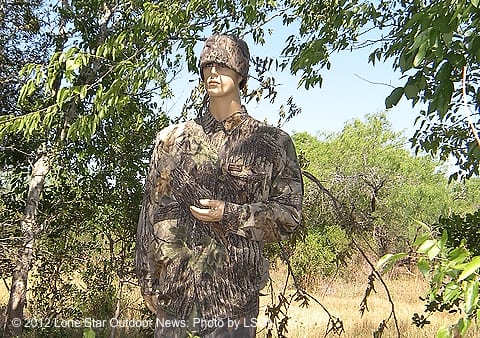 Research projects in wildlife management can be fun, especially when they involve white-tailed deer, game cameras and mannequins.
Research projects in wildlife management can be fun, especially when they involve white-tailed deer, game cameras and mannequins.
Dr. Scott Henke, Regents Professor and Chair of Animal Rangeland and Wildlife Science at Texas A&M-Kingsville, suggested the project to Brodie Carroll, a junior wildlife management student at the university.
“He suggested a camouflage vs. street clothes project looking at whitetail feeding habits.” Carroll said. “We jumped on it.”
With another undergraduate student, Michael Shipley, Carroll got to work.
“Dr. Henke got us two mannequins and we dressed one in full camo and the other in street clothes,” he said. “And we got a few feeders and game cameras.”
The street clothes consisted of blue jeans, a plaid shirt and a blue cap.
“We did 10 days with each (camo and street) mannequin right out front of the feeder; along the brushline; and in the brush hidden like a hunter would be,” Carroll said.
Poor range conditions limited them at first.
“Because of the drought, very few deer were coming in at all at first,” Carroll said. “We moved the feeders closer to the King Ranch fenceline and then more deer came in.”
With either mannequin out in the open, very few deer came in because of the human form, but Henke was surprised by one finding.
“Interestingly, the javelina, feral hogs and raccoons still came right in and fed,” Henke said. “The mannequin didn’t seem to bother them at all.”
Along the brushline Carroll noticed a slight difference after viewing all of the images from the camera.
“The deer stayed on the camera longer when the camo mannequin was in place compared with the street clothes mannequin,” Carroll said. “It may have been harder for them to make out the human form in the one wearing camo.”
When the mannequins were concealed well into the brush, “it didn’t matter at all,” Carroll said.
One item not studied was movement.
“We talked about setting up some mechanical movement in the mannequins to study it some more — I think that would matter and the camo would help mask the movement,” Carroll said. “But the mannequins cost about $500 each and we had to agree to donate them to the fashion department at school so they would get double the usage out of them.”
Henke noted that this project and others conducted by students in the department, aren’t meant to be pure scientific research.
“We do a lot of the research projects for fun as opposed to pure scientific research,” he said. “We look at the campfire stories and try to determine if they are true or if they may be a myth.”
One such project involved having both students and townspeople look at feral hogs in traps and try to guess the hog’s weight.
“Most people overestimated the hog’s weight by at least 100 pounds,” he said. “And it didn’t matter if it was a big hog or an average hog.”
Carroll hunts and also guides whitetail hunters, and isn’t changing any of his tactics based on the project.
“Deer react to movement,” he said. “When I’m hunting or guiding I sure don’t want them taking off because they saw me — I’m always in full camo.”

